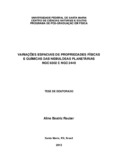| dc.creator | Rauber, Aline Beatriz | |
| dc.date.accessioned | 2017-05-02 | |
| dc.date.available | 2017-05-02 | |
| dc.date.issued | 2013-08-30 | |
| dc.identifier.citation | RAUBER, Aline Beatriz. Spatial variations of physical and chemical properties of the planetary nebulae NGC 6302 and NGC 2440. 2013. 192 f. Tese (Doutorado em Física) - Universidade Federal de Santa Maria, Santa Maria, 2013. | por |
| dc.identifier.uri | http://repositorio.ufsm.br/handle/1/3921 | |
| dc.description.abstract | We present an analysis of the physical and chemical conditions of the planetary
nebulae NGC 6302 and NGC 2440 through spatially resolved spectroscopy. Long slit
spectrophotometric data were obtained with the Goodman spectrograph attached to the
4.1m SOAR telescope in several different declinations with the slit on the East-West direction.
From them, maps and spatial profiles were constructed. Electron densities were
calculated from the [S II] and [Ar IV] sensors. For NGC 6302, a peaked distribution was
found, with the densest area at the circumstellar region, reaching Ne ≈ 40000cm−3 and
decreasing to Ne ≤ 1000cm−3 at the bipolar lobes. Knots with Ne ≈ 2000−3000cm−3
were also observed. In the maps of NGC 2440, densities reach more than 4500cm−3 in
the central structures. Structures with 1000 < Ne < 1500cm−3 are associated with the bipolar
lobes at P.A.≈ 60◦ and P.A.≈ 85◦. The average values of the electron temperature
maps in NGC 6302 were 12304K and 17380K for Te(NII) and Te(OIII), respectively. In
NGC 2440, these same values were 11273 K and 13722K, respectively. Small temperature
flutuations on the plane of the sky were obtained, with 0,00196 ≤ t2
s (NII) ≤ 0,01198
and 0,00777 ≤ t2
s (OIII) ≤ 0,00181 for NGC 6302, and 0,00107 ≤ t2
s (NII) ≤ 0,00977 and
0,00131 ≤ t2
s (OIII) ≤ 0,01728 for NGC 2440. Abundances of N+, O+, S+, O2+, Ne2+,
Ar3+ relative to H+ were determined from collisionally excited lines, and relative abundances
of He+ and He2+ from recombination lines. The highest dispersions relative to the
mean ionic abundances (50% to 70%) were observed for the N+/H+, O+/H+ and S+/H+
maps. Regions suggesting an inhomogeneous distribution of He and N were observed
in the maps of He/H and N+/O+ of the nebulae. In the diagram logHa/[NII] versus
logHa/[SII] no indication of shock excitation in any one of the structures of these objects
was found in the spatial scale of our analysis. | eng |
| dc.description.sponsorship | Conselho Nacional de Desenvolvimento Científico e Tecnológico | |
| dc.format | application/pdf | por |
| dc.language | por | por |
| dc.publisher | Universidade Federal de Santa Maria | por |
| dc.rights | Acesso Aberto | por |
| dc.subject | Meio interestelar | por |
| dc.subject | Nebulosas planetárias | por |
| dc.subject | Espectroscopia | por |
| dc.subject | Interstellar medium | eng |
| dc.subject | Planetary nebulae | eng |
| dc.subject | Spectroscopy | eng |
| dc.title | Variações espaciais de propriedades físicas e químicas das nebulosas planetárias NGC 6302 e NGC 2440 | por |
| dc.title.alternative | Spatial variations of physical and chemical properties of the planetary nebulae NGC 6302 and NGC 2440 | eng |
| dc.type | Tese | por |
| dc.description.resumo | Apresentamos uma análise das condições físicas e químicas das nebulosas planetárias
NGC 6302 e NGC 2440 através de espectroscopia espacialmente resolvida.
Dados espectrofotométricos de fenda longa foram obtidos com o espectrógrafo Goodman
acoplado ao telescópio SOAR de 4,1m em várias declinações diferentes com a
fenda na direção Leste-Oeste. A partir deles, mapas e perfis espaciais foram construídos.
Densidades eletrônicas foram calculadas a partir dos sensores [S II] e [Ar IV].
Para NGC 6302, uma distribuição de pico foi encontrada, com a área mais densa na
região circum-estelar, atingindo Ne ≈ 40000cm−3 e diminuindo para Ne ≤ 1000cm−3 nos
lóbulos bipolares. Condensações com Ne ≈ 2000−3000cm−3 foram também observadas.
Nos mapas de NGC 2440, as densidades chegam a mais de 4500cm−3 nas estruturas
centrais. Estruturas com 1000 < Ne < 1500cm−3 são associadas com os lóbulos
bipolares em P.A.≈ 60◦ e P.A.≈ 85◦. Os valores médios dos mapas de temperatura
eletrônica de NGC 6302 foram 12304K e 17380K para Te(NII) e Te(OIII), respectivamente.
Em NGC 2440, estes mesmos parâmetros foram 11273K e 13722K,
respectivamente. Pequenas flutuações de temperatura no plano do céu foram obtidas,
com 0,00196 ≤ t2
s (NII) ≤ 0,01198 e 0,00777 ≤ t2
s (OIII) ≤ 0,00181 para NGC 6302, e
0,00107 ≤ t2
s (NII) ≤ 0,00977 e 0,00131 ≤ t2
s (OIII) ≤ 0,01728 para NGC 2440. Abundâncias
de N+, O+, S+, O2+, Ne2+, Ar3+ relativas ao H+ foram determinadas a partir
de linhas excitadas colisionalmente, e abundâncias relativas de He+ e He2+ a partir de
linhas de recombinação. As maiores dispersões em relação às abundâncias iônicas médias
(50% a 70%) foram observadas para os mapas N+/H+, O+/H+ e S+/H+. Regiões
que sugerem uma distribuição inomogênea de He e N foram observadas nos mapas de
He/H e N+/O+ das nebulosas. No diagrama logHa/[NII] versus logHa/[SII] nenhuma
indicação de excitação por choque em qualquer uma das estruturas destes objetos foi
encontrada na escala espacial de nossa análise. | por |
| dc.contributor.advisor1 | Copetti, Marcus Vinicius Fontana | |
| dc.contributor.advisor1Lattes | http://lattes.cnpq.br/2566375872711558 | por |
| dc.contributor.referee1 | Costa, Roberto Dell'aglio Dias da | |
| dc.contributor.referee1Lattes | http://lattes.cnpq.br/8031266925341697 | por |
| dc.contributor.referee2 | Oliveira, Vinicius de Abreu | |
| dc.contributor.referee2Lattes | http://lattes.cnpq.br/2010283569069232 | por |
| dc.contributor.referee3 | Schmidt, Alex Andre | |
| dc.contributor.referee3Lattes | http://lattes.cnpq.br/4279165283013379 | por |
| dc.contributor.referee4 | Riffel, Rogemar André | |
| dc.contributor.referee4Lattes | http://lattes.cnpq.br/7535636807201892 | por |
| dc.creator.Lattes | http://lattes.cnpq.br/7034926604788495 | por |
| dc.publisher.country | BR | por |
| dc.publisher.department | Física | por |
| dc.publisher.initials | UFSM | por |
| dc.publisher.program | Programa de Pós-Graduação em Física | por |
| dc.subject.cnpq | CNPQ::CIENCIAS EXATAS E DA TERRA::FISICA | por |


